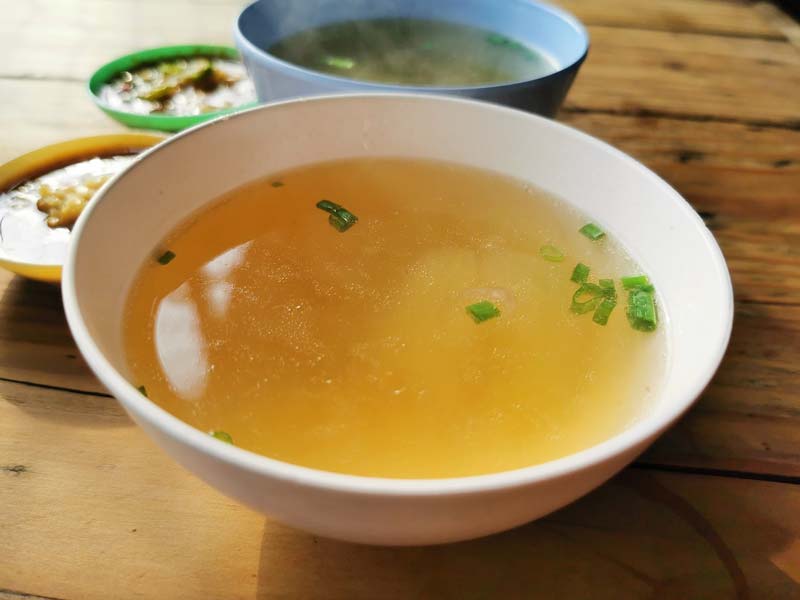
Ingredients
- 1 whole soup chicken (organic quality) for chicken stock or
- 1 kg beef bone (leg slice, oxtail, marrow bone – organic quality or from the butcher) for bone broth
- 1 bunch of greens
- 2 tbsp apple cider vinegar (important, do not omit!)
- optional: bay leaf, spice grains, thyme, ginger if you like
- Pepper
- Salt (omit if you want to reduce the stock later, otherwise it could become too salty)
Preparation
- Cook in a slow cooker (electric cooker) for at least 8 hours, preferably 24 hours at a low temperature.
- Strain through a fine sieve or kitchen paper so that even small pieces of bone are filtered out; discard the solids
- Reduce (i.e. allow to boil down, then gels)
- Process for soup, sauces, etc. or freeze in portions or preserve in screw-top jars
A slow cooker is an electric cooking pot with a lid that only requires a power socket, but no stove. There are various models and sizes. A 3-liter pot is usually sufficient for a 2-person household, and there are also big differences in price. There are many dishes that can be prepared with it, there are special cookbooks, YouTube videos and websites.
The slow cooker only heats the food up to a predetermined temperature, e.g. 72 °C or 92 °C, and keeps this temperature constant for the entire time. The cooking time is at least 4 hours, ideally 8 hours, for broth even 24 hours. This allows the ingredients to slowly dissolve from the ingredients, are not destroyed by high temperatures and are not lost by pouring. As the broth does not boil but rather infuses slowly, you don’t need to keep checking on it and can leave the pot overnight or while you are away from home. This method of preparation is ideal for working people who put their food on in the morning and have a warm meal after work, as the slow cooker also has a keep-warm function. Under the name “bone broth to go”, there was a boom in street kitchens in America that sold hot bone broth in paper cups to take away, just like coffee to go here.
Why is bone broth brain food?
- the amino acids extracted from bones, tendons, ligaments and meat can be easily absorbed by the human body because they have already been broken down for the most part during the long cooking process
- Minerals such as magnesium, calcium, potassium, silicon, sulphur and phosphorus are also dissolved in the aqueous broth and are therefore also easily absorbed
- Bone broth has a high content of gelatine, which consists of collagen and glycosaminoglycans such as hyaluronic acid, glucosamine and chondroitin sulphate. These substances all have regenerative effects in joints, vision, ligaments and other connective tissues. This counteracts muscular tension, which often occurs as a side effect of stress.
- The most abundant amino acids are glycine (35%), proline, glutamine and hydroxyproline
- Glycine is an amino acid that is primarily required for the formation of the neurotransmitter GABA (gamma-amino-butyric acid). GABA is the most important inhibitory neurotransmitter, without it we would not be able to calm down. Glycine is also a starting material for our body’s most important antioxidant, glutathione, and therefore has an anti-inflammatory effect.
- Glutamine is the preferred energy source of the cells lining the gastrointestinal tract, which is why chicken soup contributes to the healing of leaky gut syndrome. A large proportion of the neurotransmitters that are also used in the brain are formed in the gut, so it is important that the gut can work well.
- The amino acid proline released in the bone broth is needed by the body to heal wounds and build up connective tissue as well as skin, cartilage, bones and the vascular system. This is, among other things, anti-wrinkle protection from the inside.
Chicken broth has long been used as a tonic and restorative for the sick and convalescent. So if you ever feel sickly, depressed or lacking in energy, eat or drink bone broth or chicken broth.
If you want to use the ingredients as brain food, cook up a supply and preserve it so that you always have some on hand. If possible, you should eat it once a week, as a broth for dinner, as a soup for lunch or as a sauce base for the Sunday roast.
Enjoy your meal!
I found an interesting page on the subject of collagen here: https://www.mentalfoodchain.com/lebensmittel-mit-kollagen/



